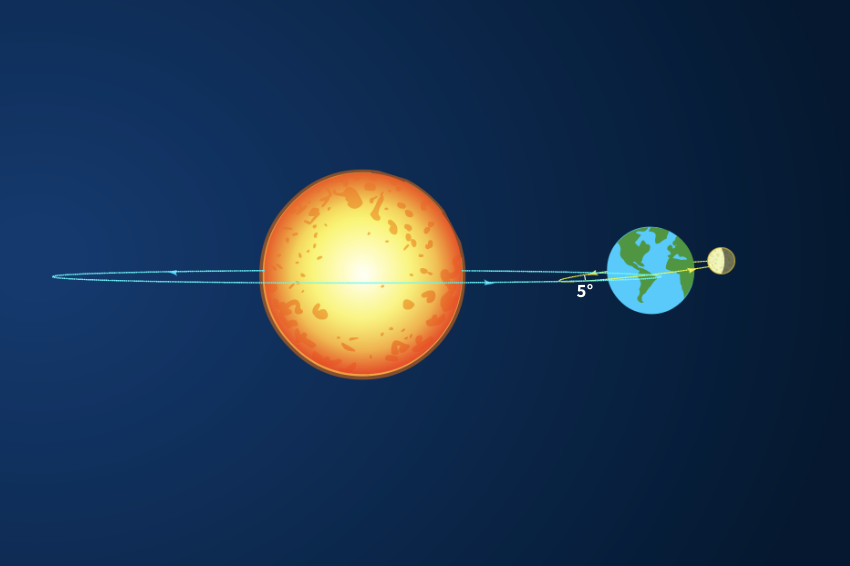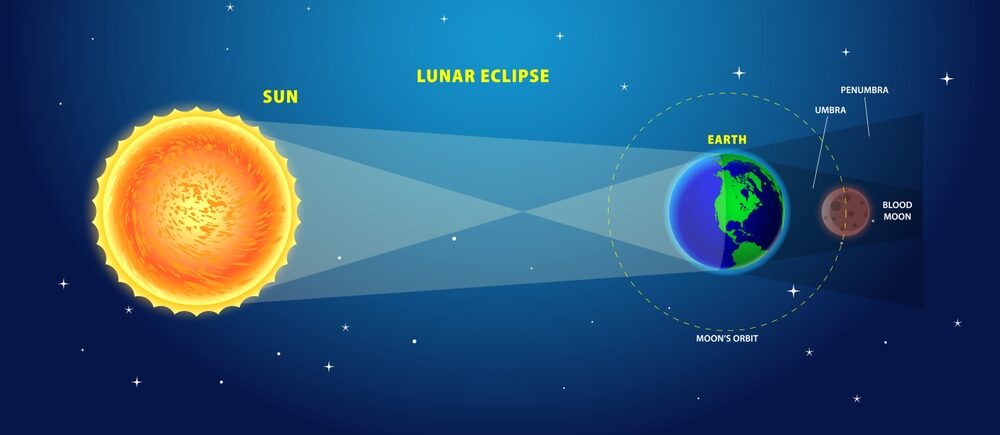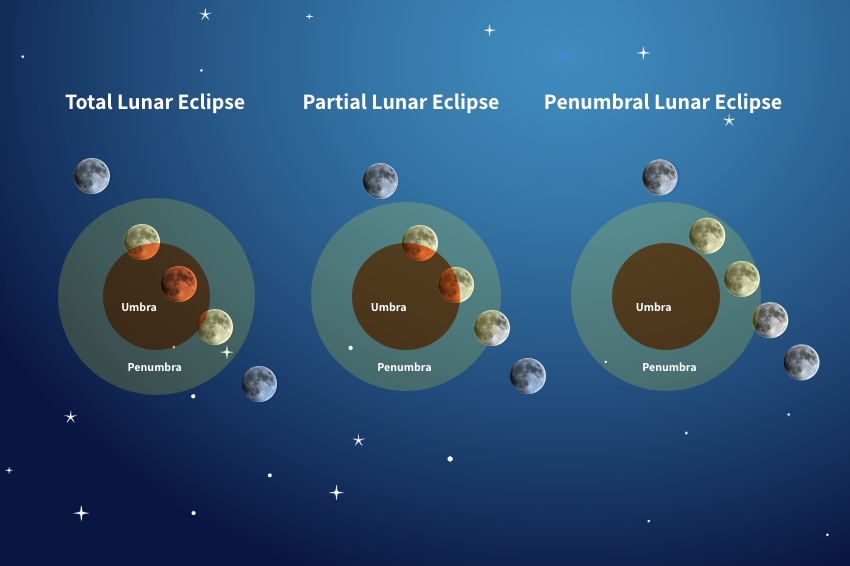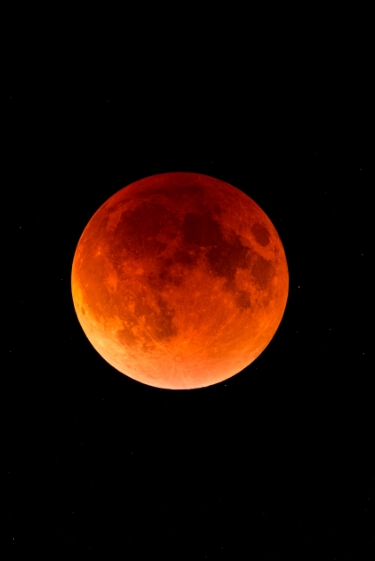In Earth’s Shadow: Blood Moon Lunar Eclipse or, When the Moon Turns Red
A total lunar eclipse on September 7 was visible across much of Asia, Africa, and Australia. How does such an eclipse occur? What could observers see during the event, and at what times? And when will the next eclipse take place?
The Earth has been orbiting the Sun for more than 4.5 billion years, and the Moon has been circling Earth for nearly as long. Every so often, the three bodies align in a straight line. When the Moon is in the middle, it blocks the Sun—fully or partially—for observers on Earth, creating a solar eclipse. When the Earth is in the middle, its shadow falls across the Moon, producing a lunar eclipse. In such cases, the Moon does not disappear completely but instead glows a deep red, a striking sight often referred to as a “Blood Moon.”
A total lunar eclipse took place on September 7–8, 2025. Depending on location, viewers were able to watch the event in its entirety or in part. It was fully visible across much of Asia, Africa, and Australia, while observers in Europe and parts of the Pacific could catch portions of the eclipse as the Moon rises or sets. The Americas, however, missed this one because the event occured during their daylight hours.
When Does a Lunar Eclipse Occur?
The planets, including Earth, orbit the Sun on the same plane, called the ecliptic plane (from the word “eclipse”). The Earth completes one orbit around the Sun in about 365 days, carrying the Moon with it. The Moon, in turn, revolves around Earth and completes an orbit in about 29 of our days. If the Moon orbited Earth on exactly the same plane in which Earth orbits the Sun, we would see a solar and lunar eclipse every month. But to make life a bit more interesting, the Moon’s path around Earth is tilted by five degrees compared to the ecliptic plane. This means that instead of every month, only about twice a year do the three bodies align in a straight line. When this happens, we get both a lunar and a solar eclipse, about two weeks apart: a lunar eclipse can occur only when Earth is between the Sun and the Moon—that is, during a full Moon—while a solar eclipse requires the Moon to be between Earth and the Sun, which happens at new Moon. Indeed, on September 21 a partial solar eclipse will occur, but it will be visible mainly from New Zealand, the South Pacific Ocean, and parts of Antarctica.
The planets, including Earth, orbit the Sun on the same flat plane, called the ecliptic plane (the source of the word eclipse). Earth completes one orbit around the Sun in about 365 days, carrying the Moon along with it. The Moon, in turn, completes an orbit around Earth about once every 29 Earth days. If the Moon’s orbit lay exactly on the same plane as Earth’s orbit around the Sun, we would experience a solar and lunar eclipse every month. But the Moon’s path is tilted by about five degrees relative to the ecliptic. Because of this small tilt, perfect alignment of the three bodies happens only about twice a year. When such alignment takes place, both a lunar and a solar eclipse usually occur about two weeks apart. A lunar eclipse can happen only at full Moon, when Earth lies directly between the Sun and the Moon. A solar eclipse, by contrast, requires a new Moon, when the Moon passes between Earth and the Sun. Indeed, following the total lunar eclipse of September 7, 2025, a partial solar eclipse will occur on September 21, visible mainly from New Zealand, the South Pacific, and parts of Antarctica.

The Moon’s orbit around Earth is tilted by five degrees relative to the ecliptic plane. Because of this, the Sun, Moon, and Earth align in a straight line only about twice a year on average. Illustration: Liat Peli, with elements by grayjay/Shutterstock.
What Happens During a Lunar Eclipse?
A lunar eclipse occurs when Earth’s shadow falls across the Moon. In theory, because Earth is much larger than the Moon, it could block all sunlight and cause the Moon to vanish completely during a total eclipse. But Earth has an atmosphere, and that makes all the difference. The same atmosphere that sustains life on our planet also bends sunlight, deflecting it so that some rays that would otherwise miss the Moon still reach its surface.
Sunlight is made up of many colors, each defined by a different wavelength. The shorter waves, which correspond to higher frequencies such as blue and violet, are scattered more strongly in Earth’s atmosphere than the longer, lower-frequency waves that appear reddish. This is also why the sky takes on a reddish hue at sunset: when the Sun is near the horizon, its rays pass through a longer stretch of atmosphere, the shorter waves scatter away, and the reds reach us. During a lunar eclipse, the light rays that eventually reach the Moon have traveled through this same long atmospheric path, and are thus mostly red — giving the Moon a coppery, blood-like glow. This is why a total lunar eclipse is often called a “Blood Moon.”

When Earth’s shadow falls on the Moon, it glows red because Earth’s atmosphere scatters most of the other wavelengths. Diagram of a lunar eclipse | Illustration: Albert Stephen Julius, Shutterstock
What Types of Lunar Eclipses Exist?
Earth’s shadow, like that of any object blocking light, is made up of two regions. The first is the umbra — the central area where sunlight is completely blocked. The umbra is roughly circular in shape. Surrounding it is the penumbra, a lighter outer ring where sunlight is only partially blocked and some rays still filter through.
A total lunar eclipse occurs when the entire Moon passes into the umbra, the darkest part of Earth’s shadow. During this phase — when the Moon is fully immersed in shadow — no direct sunlight reaches it, and it takes on a reddish glow. The length of this total phase depends on how close the Moon comes to the shadow’s center: the nearer it is, the longer the eclipse lasts. When the Moon passes directly through the center of Earth’s shadow, the total phase of the eclipse — known as totality — can last up to about two hours. A partial lunar eclipse happens when the Moon does not fully enter the umbra, leaving only part of its surface covered by the reddish shadow. A penumbral lunar eclipse occurs when the Moon passes only through the penumbra, producing a faint dimming or shading that is often difficult to notice with the naked eye. Every total eclipse also includes penumbral and partial phases at its beginning and end, as Earth’s shadow gradually moves across the lunar surface and then recedes.
Whether you can see a lunar eclipse depends on your location. To observe one, it must be nighttime in your part of the world when the event takes place, and for the full sequence to be visible, the entire eclipse must occur after the Moon has risen and before it sets in your region. Aside from the regions where the eclipse can be seen from start to finish, in many regions only part of the event is visible—for instance, where the Moon rises after the eclipse has already begun, or sets before it has ended, leaving only the partial or penumbral phases in view.

The type of eclipse is determined by how the Moon passes through Earth’s shadow: total eclipse (left), partial eclipse (center), and penumbral eclipse (right), where the Moon passes only through the penumbra. | Illustration: Liat Peli
What Could be Seen Around the World?
The total lunar eclipse of September 7, 2025 unfolded over several hours, with visibility depending on location. In regions where the eclipse was seen in full, the penumbral phase began earlier in the evening, followed by the partial eclipse as Earth’s shadow crept across the Moon. The total phase started at 20:30 UTC and lasted for 82 minutes, during which the Moon glowed a deep red. The eclipse reached its maximum at 21:11 UTC, then gradually shifted back into a partial stage before ending with a faint penumbral shadow just before midnight UTC.
Observers across Asia, Africa, and Australia had the best views, with the eclipse visible in its entirety from moonrise to moonset. In Europe, many could watch the later stages as the Moon rose already in shadow, while in parts of the Pacific, the Moon set before the eclipse was complete. Across the Americas, the event coincided with daylight and was not visible.
For those who missed this eclipse, the next opportunity will come soon. A partial lunar eclipse will take place on August 28, 2026, visible from much of the Eastern Hemisphere, followed by a total eclipse on December 31, 2028, and two more totals in June and December 2029.

The total eclipse lasted 82 minutes, framed by partial and penumbral phases before and after. Diagram of eclipse times worldwide | Illustration: Liat Peli






